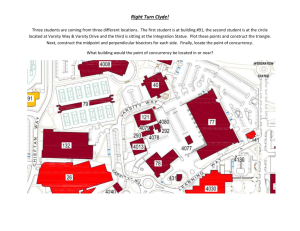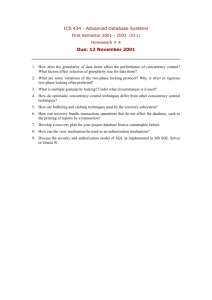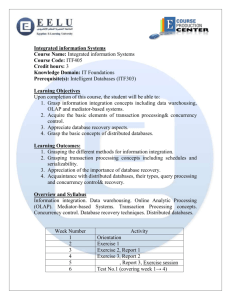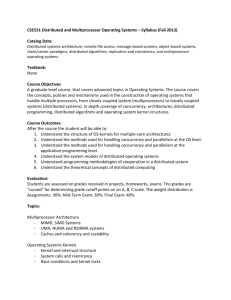Précis
advertisement
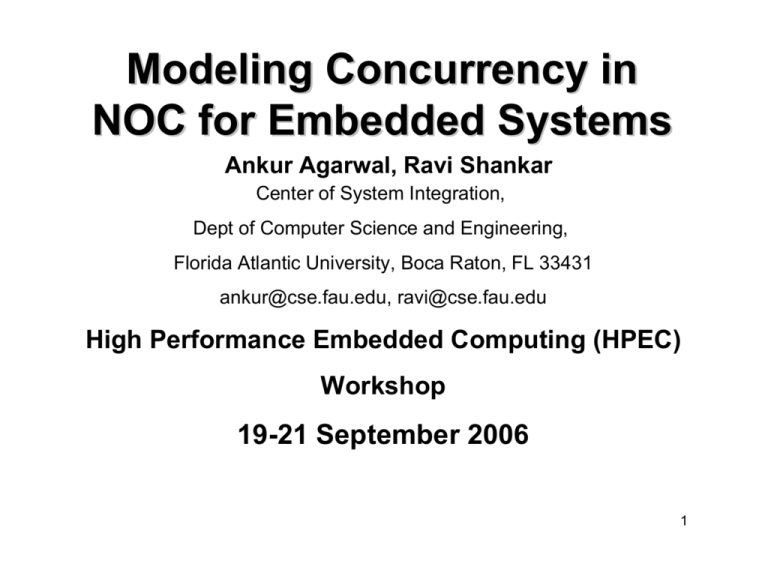
Modeling Concurrency in
NOC for Embedded Systems
Ankur Agarwal, Ravi Shankar
Center of System Integration,
Dept of Computer Science and Engineering,
Florida Atlantic University, Boca Raton, FL 33431
ankur@cse.fau.edu, ravi@cse.fau.edu
High Performance Embedded Computing (HPEC)
Workshop
19-21 September 2006
1
CONCURRENCY MODELING
Multi-Core
Concurrency
Issues
• Concurrency Trend
– Multi-core Architectures
Deadlock/
Livelock
• Advantages of Concurrency Modeling
– Better Performance
– Lower Power Dissipation
– Higher Reuse
2
CONCURRENCY FAILURES
• Pitfalls of Concurrency
– Intermittent & Catastrophic failures
– Not a Traditional Coding Style
– Poor Specification – Large Integration Time
Example of Concurrency
Failures
–Denver Airport Baggage System
–Airplane Software Glitch
3
CONCURRENCY MODELING
WITH FSP
• Goals: Reduce Concurrency time,
concurrency failures & ease architectural
selection
• FSP: A Systematic approach to
concurrency modeling
• LTSA: Used for exhaustive analysis
• UML to Concurrency Modeling
• Powerful methodology for concurrency
modeling
4
CONCURRENCY MODELING
FLOW DIAGRAM
High Level System
Specification
Identify Concurrent
Processes
Model Process
Interactions
Analyze System for
Deadlock/Livelock/
Starvation
Re-Do Component
Specification
5
NETWORK ON CHIP
ARCHITECTURE (NOC)
• Multi-core
B
Architecture
B
• Reusable
P/C
Communication
B
Sub-System
B
P/C
• Enhances
Productivity
B
B
• Manages
P/C
Complexity
B B
N
S
N
I
B B
B
B
B
B
B B
N
S
N
I
B B
B
B
B B
B B
N
I
B
B
B B
N
S
N
I
N
S
N
I
B
B
B
B
B B
B
B
B B
N
I
B
B
B B
N
S
N
I
B B
B
B
B
B
B B
P/C
N
S
P/C
B B
B
B
B
B
B B
P/C
B B
N
I
P/C
B B
B
B
N
S
B B
P/C
N
S
B
B
N
S
N
I
B
B
B B
P/C
6
CONCURRENCY IN NOC
ARCHITECTURE
• 3×3 NOC Mesh Architecture includes
– Forty Five Input Buffers
– Forty Five Output Buffers
– Nine Network Interfaces
– Nine Producers
– Nine Consumers
– Nine Schedulers
– Nine Routers
• Will there be concurrency issue among
these component interactions?
7
HIGH LEVEL SUB-SYSTEM
SPECIFICATION
1. Data will be received in serialized packet
format
2. Several data paths will be available arranged
in a matrix fashion for data forwarding
3. Data packets may be buffered at each
intersection
4. Further routing will be available based on the
availability & congestion of links at the
destination
5. packet will contain destination address &
Priority
6. Links may be unidirectional (2 links for each
direction) or bi-directional
8
COMPONENT SPECIFICATION
1. Link Specification
1. Collects the data from the source
2. Forwards the data to the buffer
2. Buffer Specification
1. Store Input Data: Data sent by Link
2. Forward the data to the output: Data sent to
the node
3. Inform about the buffer status: buffer is
empty, buffer is full
4. Forward the high priority data first
9
3. Scheduler Specification
1. Receives the request from the buffer for
forwarding the data to the node
2. Forwards the request for transmitting data
3. Checks the availability of data path for a data
packet
4. Node Specification
1. Determines the route information
2. Gets the data from buffer
3. Forwards the data to a buffer
5. Producer/Consumer Specification
1. Forwards the data packet to the buffer based on
buffer availability
2. Accepts the data packet from the buffer
10
MODEL PROCESS
INTERACTIONS ONLY (NOT
INTERNAL ACTIONS)
Example:
PRODUCER = (buffAvail -> {hiPriDataOut,loPriDataOut} ->
PRODUCER).
Process Abstraction
11
DEVELOP MODEL
INCREMENTALLY
1. 1st we analyzed Producer (P) and Buffer (B)
Process
2. Introduced Link (L) Process
3. Analyzed the interaction among P,B & L
4. Added Node (N) & scheduler (S) processes
5. Analyzed Interaction among P, B, L, N & S
processes
6. Later: Addition of consumer (C) process
12
MODEL ABSTRACTION
• Initial Model
P
B
L
B
B
L
B
N
B
N
B
L
B
N
B
L
B
N
B
B
C
• Abstracted Model
P
B
N
B
C
B
N
B
13
RESULTS
Compiled: BUFFER
Compiled: SCHEDULER
Compiled: PRODUCER
Composition:
FINAL1 = b1:BUFFER || b2:BUFFER || s1:SCHEDULER || p1:PRODUCER
State Space:
24 * 24 * 9 * 2 = 2 ** 15
Composing...
-- States: 351 Transitions: 882 Memory used: 3043K
Composed in 110ms
FINAL1 minimising........
Minimised States: 351 in 46ms
No deadlocks/errors
Progress Check...
-- States: 351 Transitions: 882 Memory used: 3397K
No progress violations detected.
Progress Check in: 31ms
14
CONCLUSION
9 Concurrency Modeling will ensure that there
are no deadloack/livelocks in a system
9 Easier & quicker to integrate components into
a subsystem, and a subsystem into a system
9 Concurrency modeling at an early stage will
speed up system modeling and analysis
9 Enhanced Component Reuse via subsystem
Design Patterns
15
